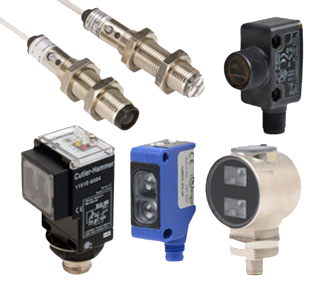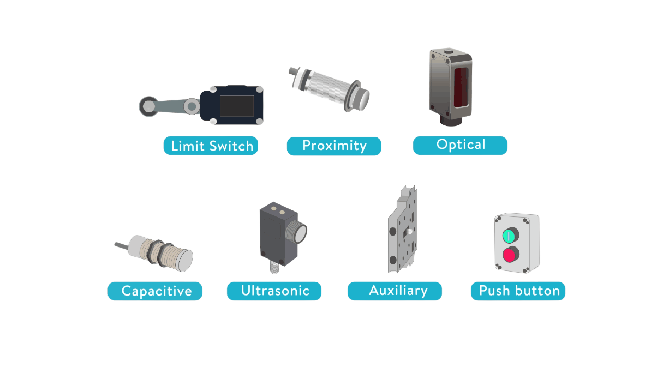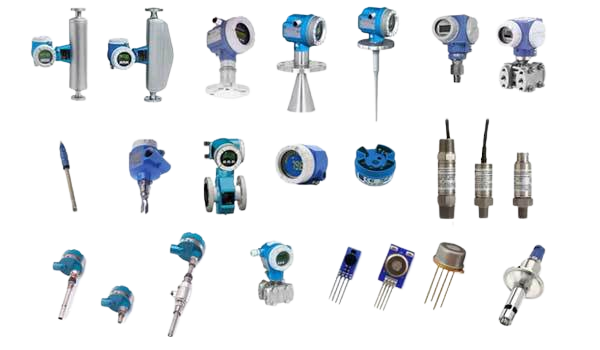Industrial Sensors
Industrial Sensors are sensors that equipment and systems use to measure physical quantities. They also measure and feel the existing conditions. Finally, the result is recorded and displayed. There are different types of sensors that are used in control and automatic and intelligent equipment from smartphones to factories and wide industries. Of course, the sensors of small devices are different from the sensors that are used in the industry.
Sensors used in industry must follow standards. And this makes it possible to use them only with special industrial controllers. All kinds of industrial sensors and parts that are responsible for sensing and measuring quantities such as temperature, pressure, movement and even light are the main part of factories. Because practically, without measuring the environmental conditions such as temperature and pressure, the controllers cannot issue the desired commands and advance the processes. In this article, we are going to introduce you to all kinds of industrial sensors, stay with us.
Table of Contents:
- What is an industrial sensor?
- Types of industrial sensors based on output signals
- Types of industrial sensors based on their performance
- Other types of common sensors in the industry
- Where to identify and buy the right sensors?
What is an industrial sensor?
In general, sensors are said to be parts that have the ability to detect the surrounding conditions. These conditions can be the ambient temperature or the amount of ambient light, or our goal in designing the sensors may be to detect humidity. In simpler terms, a sensor is designed to be sensitive to humidity, temperature, pressure, movement or light intensity, etc. The way it works is that by changing any quantity and measuring the amount of change, the electric output of the sensor will change compared to the normal state.
Due to the easy and fast transfer of electrical energy, the output of all types of industrial sensors is electrical. And this output will be in the form of dedicated signals. Finally, this signal is processed by another device called controller and it is used to control devices and control commands.
Types of industrial sensors based on output signals
To use and prepare sensors, it is necessary to be familiar with the types of electrical output signals. Sensor output signals can be classified into five different categories. These five signals that cause five categories of sensors are:
Type A:
Sensors with the nature of connecting and disconnecting the output (digital) such as proximity sensors, pressure, liquid level measurement, etc. These types of sensors can mainly be directly connected to the PLC device.
Type B:
Sensors whose output signal is pulsed. Such as sensors for measuring the amount of rotation or length, etc. These types of sensors can mostly be connected to the PLC device through an interface. In this case, the PLC must have software and hardware counters.
Type C:
Sensors whose output signal is analog but does not have an amplifier or converter. These signals are very weak (millivolts) and cannot be directly used in control devices. such as piezoelectric sensors or Hall sensors
Type D:
Sensors whose output signal is analog and the electronic unit (amplifier, converter) is embedded in the sensor itself. In this type of sensors, the output can be used directly in the controller devices.
Type E:
Sensors whose output signal is in accordance with the standards of industrial networks. Such as C-232-RS, A-422-RS, 485-RS or Fieldbus direction such as Profibus, ASI, etc. are considered.
Types of industrial sensors based on their performance
Sensors are classified according to their function as follows:
Contact sensors:
These types of sensors are used in various connections between actuators or operators, especially in final factors. And they can be separated into two models. Contact detection sensors and force-pressure sensors.
Resistive sensors:
Resistive sensors are actually a transducer or an electromechanical device. which converts mechanical changes such as displacement into an electrical signal. and sent to the controller. They are usually used in precision instruments. The simplest example for a resistance sensor is a potentiometer.
Voltage sensors:
The main task of this sensor is to detect and measure AC or DC voltage. When the presence and magnitude of the voltage is detected, the sensor can provide or send output in the form of current levels, analog voltage signals, output of regulated frequencies or audible alarms.
Flow sensors:
The flow sensor (flow meter) senses or measures the flow rate of fluids such as liquids and gases in pipes. Usually, these sensors are used in HVAC systems, chemical plants and septic systems and production line pipes. Flow sensors can detect leaks, blockages, pipe bursts, and changes in liquid concentration due to fouling or fouling of the flow sensor. This sensor detects electric current. and converts it into a voltage corresponding to the sensed detection current.
Capacitive sensors:
These sensors are among the types of non-contact sensors that can be used for metals and non-metals. Capacitive sensors are used to control the level of tanks containing powdery, liquid or granular materials. In the industry, capacitive sensors are used for control purposes. It is also used to count the number of objects or detect the rupture of the conveyor belt. In addition to these cases, they are also used to control the filling of liquids in production lines.
Inductive sensors:
Inductive sensors are non-contact sensors. The basis of their work is based on magnetic circuits. For this reason, they are also called electromagnetic sensors. The disadvantages of these sensors are that they only react against metals. And one of their advantages is direct control of relays, solenoid valves, measuring systems and electrical control circuits.
The application of inductive sensors can be used in measuring the distance from the part, separating parts with different dimensions, measuring the thickness of metal parts, separating the metal part of the parts, detecting broken metal parts of various industrial devices, revealing any changes in the gear teeth.
Optical and laser sensors:
Optical sensors are among the types of proximity or contact sensors. Their work is based on sending and receiving modulated light. This light can include the spectrum between the visible green light spectrum and the invisible infrared light. Most of them use infrared light with a wavelength of 880mm in the manufacture of optical and laser sensors. The optical sensor converts light rays or lasers into electronic signals and sends them to the rest of the system equipment. In short, this device measures the physical quantity of light. and then converts it into a form that can be read by the intended device of the system.
Chemical sensors:
Using chemical sensors, it is possible to measure and record the concentration of special particles in the desired gases or liquids using an electrical signal (voltage or current). In cases where these sensors are responsible for detecting special biological substances. This sensor is known as biological sensors. which are often considered a separate category of chemical sensors.
Chemical sensors have many differences from physical sensors. The first difference is the number of chemical species that the sensor can sense. And they act accordingly, usually very high. As an example of the use of this number of compounds and chemical species, we can mention its use for experiments in medical laboratories. The act of sensing and measuring chemicals can be done using analytical chemistry methods, for example with the help of mass spectrometers, optical or magnetic methods, or gas chromatographs.
Magnetic sensors:
Magnetic sensors are contact or proximity sensors. The basis of their operation is based on the sensitivity to the magnetic field around the permanent or electric magnet. The main part of this tool is blade-shaped contacts made of ferromagnetic materials such as iron and nickel alloys. which are embedded inside a small tube.
These tubes are generally filled with neutral nitrogen gas. Inside a magnetic sensor, an LED is often installed to show the status of the sensor. If a magnetic field such as the magnetic field of a permanent magnet approaches the sensor. The blade-shaped contacts are attracted to the magnetic field and open or close one or more contacts.
Other types of common sensors in the industry
As we have seen so far, there is a wide variety of sensors in the industrial sector and there are unique and diverse applications for each of these items in factories, workshops, buildings, etc. Among other important and widely used sensors in the industry, the following can be mentioned:
Temperature sensor, Thermometer:
A temperature sensor is a tool used to measure the degree of heat or cold. Its task is to measure the temperature and convert it into a readable unit. It is used to measure the temperature of soil, wells, huge concrete dams or buildings, etc. Temperature sensors are typically a thermocouple or a resistance temperature detector. It converts the measured temperature into a readable form and an electrical signal.
Pressure sensor:
Pressure measurement is very important in controlling most industrial processes. The pressure sensor converts the pressure information into an electrical signal. Most pressure sensors measure the deformation of the diaphragm by applying pressure in both directions. Manufacturers use names such as “pressure sensor” and “pressure transducer” for such equipment. The term “pressure transmitter” is used for a pressure sensor equipped with electronic components. And allows providing a standardized output signal.
Touch sensor:
The touch sensor is an electronic sensor. whose task is to detect and record physical touch. These sensors are also known as touch sensors. It is a small, simple and inexpensive piece. which is a replacement for the old mechanical switches, designed and made.
Motion sensor:
A motion sensor or motion detector is a device that qualitatively detects the movement of objects or persons and informs the user or the device about the presence of this movement in the field of view. Motion sensors are one of the important implementations of security systems and bottle filling machines. Usually, the sensor detects any movement in the environment. The sensor can inform people or control systems of the measurement result as a signal or by ringing a bell or by sending a message.
Vibration sensor:
A vibration sensor is a device for measuring the amount and frequency of vibration in a system, device or piece of equipment. The output of these measurements can be used to identify the imbalance of different parts or other issues in the device and predict future failures.
Humidity sensor:
In some industries, humidity measurement is one of the most important factors. Because with the rise of humidity in a series of industries and cases, serious damages and expensive damages may be caused to the product and industry. In a series of products, humidity control is one of the most important things, especially during storage. And the humidity sensor is one of the types of industrial sensors.
Level sensor:
Level gauges or level gauges are tools that can be used to measure the level of liquids and generally the level of liquids (in some cases solids) with high accuracy. In point level measurement, the fluid level is measured at a specific point, and in level measurement, the height of the fluid inside the tank is measured.
Where to identify and buy the right sensors?
In response to these questions, it should be said that several factors should be considered for the purchase of a sensor. Each of these mentioned sensors (and other sensors that exist) have different applications according to the working conditions, and the help of an expert in this field should be sought. Our expert consultants are ready to help you choose the right sensor for your industry for free. Contact us for guidance and more information. Also you can contact us through What’sApp.




